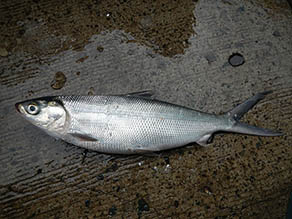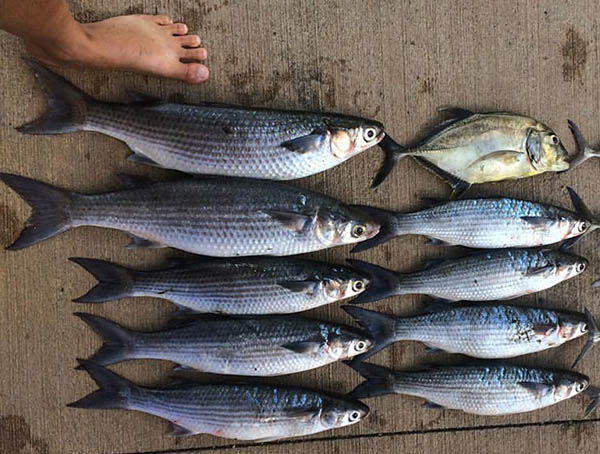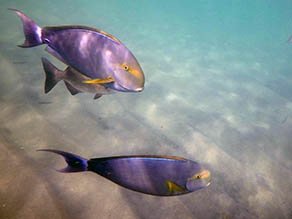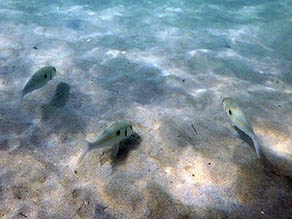 |
 |
 |
|||||
|
Types of Fish in He‘eia Fishpond:
“We have a pretty diverse set of fish inside the fishpond,” Keli‘i explains, “ranging from herbivores to omnivores to carnivores. Herbivores—the primary fishpond species that we want to raise, that we’re interested in and that were typically raised in Hawaiian fishponds—are ‘ama‘ama, which is Hawaiian striped mullet, the ‘awa, which is milk fish, pū‘alu and palani, which are two different surgeon fishes. Those are the four main species of herbivores that we’d like to have in a pond and we see them in the pond and they’re there. We have harvested them when we’ve had to. Those are fish that we are following their patterns. 
“We’re trying to watch for their spawning cycles, their feeding behaviors, just any behaviors that they exhibit. We wanted to observe, know, and become intimately interwoven with those fish because those are fishpond fish. Those are the fish that keep the fishpond healthy. Those are the fish that traditionally fed the masses, and those are fish that we want to get people excited about eating. We eat more carnivores now, those are the fish that are available in our restaurants and on menus. We want to get fishpond fish back there. It’s going to take a bit of work to change the palate of the general society but that’s why we’re doing the work that we do. “The thing I always get a kick out of,” Keahi says, “is when I ask kids what kind of fish they eat—any groups that come in, I ask what kind of fish they eat. And you can tell the carnivore fish are at the top of the list: ahi, mahi, wahoo, the pāpio, the ulua, all the pelagics. All the kids love them. But the reality is we’re growing none of those. The fish that everybody eats, we don’t grow them. And then you start showing them what kind of fish we have, and some have heard of it, some have tried it, but it's definitely not a regular diet for them. “If we raise carnivorous fish, either they’re going to eat each other or we have throw feed, we have to literally go out and feed them. That kind of takes away from a lot of things. If you’ve got to feed them every day, you need to spend money on your feed, or you need to figure out a way to make feed, and that's a whole other ballgame. But what our kūpuna did is they dedicated these fish farms to herbivorous fish. Very easy reason is because they’re not going to eat each other, but an even more amazing reason is being able to create the right environment where food is free and I think that was the ultimate kicker. Just their understanding. “Our kūpuna knew what our fish eat, so they knew when they made this environment that it was going to work. We have to put a little bit more thought process into it, I think, when it comes to ‘Oh! Mullet? What do mullet eat?’ We can try to figure it out, but I feel our kūpuna always knew. We were going through a great process of re-learning. "So in He‘eia fish pond we like to focus on our ‘ama‘ama or our mullets. They then turn into ‘anae. Once a mullet gets to a certain stage, it becomes an ‘anae and that's the big boys we have in here. What better thing to grow than something that can sustain itself in the brackish water environment?" “It’s a fishy tasting fish," Keli‘i points out. “It literally roots in the fishpond, roots around. They eat plankton and diatoms in the water column and then, given the right conditions, you’ll see them go down and scoop up a little bit of the mud and come up and expel it through their gills and you know keep what they want and push out the rest and so yeah we could say the fish eats mud. It’s going through their to find its food, so it’s not a fish that eats fish. And fish that eat fish have a certain flavor, and fish that eat seaweed or fish that eat plankton have different flavor. So it’s not a taste for everybody but I love it. It’s good, it just depends.” “I think mullet—‘ama‘ama and ‘anae—is a big favorite of a lot of the old-timers,” Hi‘ilei adds. “Just like on every island, it’s a fish that its always enjoyed steamed. It’s a pretty fishy fish, so not too many people nowadays are really fond of it just because they haven’t developed that palate.” “So we have we have ‘ama‘ama,” Keahi continues, “we have we have a lot of pū‘alu in here, a very similar fish to kala in the sturgeon family. ‘Awa—milk fish—are an amazing fish, they’re herbivorous yet they grow up to like fifty pounds, just huge, huge. They’re a very soft fish, similar to ‘ōio or bone fish, and they’re what a lot of people make fish cake out of. Bony but big, so if you get a big enough one, it’s pretty good ratio and you can get a lot of meat. If you get a smaller one, you would have to deal with a lot of bones. So we have ‘awa in here. “And then we have omnivores inside the fishpond,” Keli‘i says. “Weke and kūmū, which are different types of goat fish. We have bone fish, which is ‘ō‘io.” “The these reefs of Kāne‘ohe Bay are pretty known for their ‘ōio,” Keahi says, “because of the great environment, shallow sandy flats with a lot of crustaceans. And that’s another reason we allow ‘ōio and moi to be in here, although they are not herbivorous, because they mostly feed on the crustaceans, and they’re not necessarily eating the mullets. And they’re great fish to eat.” “‘Ō‘io, the bone fish, the meat is really soft,” Keli‘i adds, “and people scrape it and make what we call lomi‘ō‘io. It’s just like a mush but you add in green onions and limu to that, or you can make it into fish cakes which is really, really good as well too. Just do a pan fry. “We also have Pacific threadfin, which is moi. That’s a really tasty fish—nice firm, white flaky meat.” “Everybody, we all love moi,” says Keahi. “And you can find them here even though it is not the exact environment they like. But our mākāhā actually replicates what they like. Moi like waves, you find them in the shorelines where waves are breaking on the rocks and there’s a lot of bubbles. Our mākāhā can simulate that a lot of the time, so they do come in and you see them. I don't think they prefer being in the pond, although they come in what they’ll be outside the gates and sitting just in the wake enjoying that.” “Those are omnivores that we eat,” Keli‘i continues. “Sometimes in certain of their life stages, they eat crabs and shrimp so they’re technically not herbivores because they’re eating another animal. “And then we have our predators, our carnivores in the fishpond. The main ones that we have are barracuda or kākū. We have several different species of papio which are in the Jack family. As well as toau and ta‘ape, which are introduced snappers. Those fish don’t get very big but they’re voracious. It’s good to have a diverse range of species of fish inside the fishpond. You don’t want a monocrop anything ever in the world. But our ancestors recognized that, and the species distribution of fish in the fishpond is a reflection of what is out on the adjacent reef, because at some point those fish are babies and they can swim into the fishpond. So sometimes there is a regional difference in the species of fish given different fishponds because it just depends on what they have out abundant on their reef. But those are our typical species.” |
|
|||||
|
|||||



